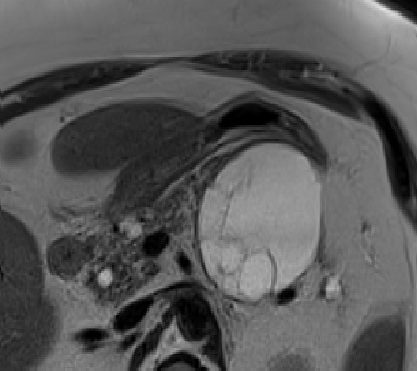We notice an increasing frequency in the detection and evaluation of pancreatic cystic lesions (PCLs) over the last three decades. They show awide spectrum of imaging and clinical features. The diagnosis and discrimination of these lesions are very important because of the risk for concurrent or later development of malignancy. The main reason is the increased awareness of these lesions and the extensive use of cross-sectional imaging, an always improving technique (1). Commonly, PCLs are diagnosed incidentally during investigation for often unrelated and nonspecific abdominal complaints using state-of-the art abdominal imaging (CT, MRT). The term PCN denotes a histologically heterogeneous collection of neoplasms showing a wide spectrum of diagnoses, ranging from completely benign to potentially malignant, to carcinoma in situ, to frankly invasive and malignant (2,3). In 1978, Compagno and Oertel were the first to recognize the crucial distinction between the serous and the mucinous cystic neoplasms of the pancreas by explaining the importance of identifying the mucinous neoplasms because of their overt or latent malignant potential (4,5). Since then, the interest in PCLs increased markedly, especially so with the recognition of the importance and prevalence of intraductal papillary mucinous neoplasms (IPMNs). Nowadays, PCLs represent a common and often difficult challenge in clinical practice, because of the increase in their detection in asymptomatic patients and our still immature understanding of some aspects of their biologic behavior. Their important differences regarding their outcome and the fact of being increasingly often identified has put a special focus on these neoplasms by surgeons, pathologists, gastroenterologists, radiologists, and oncologists alike. Management of patients with PCNs can be challenging and varies considerably among the various subtypes of PCNs. Their treatment ranges from resection of malignant lesions, to resection and/or surveillance in the case of premalignant lesions, to simple observation in the case of benign or indolent lesions. Under these circumstances, the accurate classification of PCNs becomes crucial. Therapeutic decision making and classification rely mainly on the presenting symptoms and radiologic findings, often without actual histologic tissue. It is of extreme importance to identify suspicious features indicating potential or certain malignancy in order to select the appropriate treatment. The risk of overtreatment (unnecessary pancreatectomy) should he balanced carefully with the risk of under treatment (missing the opportunity to cure a potentially curable malignant or premalignant disease).
Pancreatic Cystic Lesions: Diagnostic, Management and Indications for Operation. Part II
By adminin Publikationen